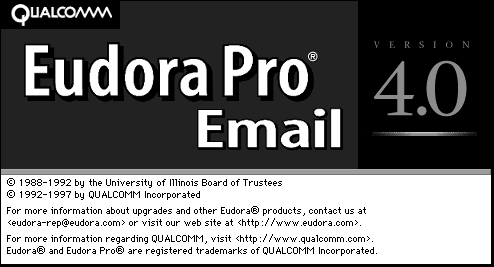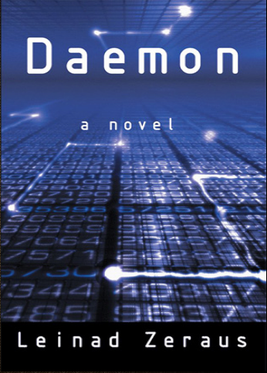
I have a confession to make: I’ve been using the same email user agent for about eighteen years. Yes… EIGHTEEN years. How many software products from 1990 do you still use?
In 1990 I was using a Macintosh IIsi, System 6.0.7, and Eudora 1. If I recall correctly it was version 1.3 or 1.5. I used my wife’s student account at the University of Washington to get online at first. A shell account on a UNIX host, a newsfeed (Newswatcher!) and trusty old Eudora for reading mail. I had a Hayes 2400baud modem at first, then I joined the 90s eventually with a Prometheus 14.4k modem, with built-in fax AND voicemail. (I was doing full-blown telephony in 1991!)
But trusty old Eudora was my mailer. It stayed my mailer.

I went through many machines (MacII, Centris 650, PowerBook 170, Duos, the infamous green 2400c subnotebook, iMacs, G4s, a TiBook that wheezed itself to death eventually, and now my current, though aging aluminum G4 PowerBook.) But Eudora remained my mailer.

I upgraded operating systems (System 7, OS8, did my best to skip OS9, jumped to X when it finally stabilized, through all the iterations of OSX up to 10.4) and Eudora kept on chugging. I managed to keep just about every bit of mail I had sent or received from about 1994 through 1998… when the great Jaz drive failure hit me as I was moving machines in the UK. Did I give up? Nope, I just started again.

Now I have just about every mail I have sent or received since 1998… all carried around in a pair of “Eudora Folders” on my hard drive (and backed up here, there, and everywhere!)
I have adapted to Eudora and it has adapted to me.
I have two distinct mail modes: work and non-work. I don’t read non-work email at work (except around lunchtime) and I TRY not to read work-related email when I am not at work, at least not on my laptop (that is what my Blackberry is for!) I have YEARS of well-tuned mail filters built (I should screen-shot them… they would astound you! Want to see them? Ask in the comments) and a signature file that is very long (it is how I have packed the “random quotes” here on my site.)
Unfortunately Qualcomm announced Eudora’s demise a while back and I knew this day would come. I test drove several other mail clients, but to be honest… all of them sucked. I know people think Eudora sucked, but it worked for me and I liked it. Hell, I stuck with it for EIGHTEEN YEARS!
I thought about Entourage. Yuck. Way too MS Office-ish. That big honking monolithic mail database terrifies me. Eudora has always stored mail is unix mbox format – plain old text files. Dealing with a corruption was just a matter of firing up BBEdit or vi. Clickty-click. I think that has happened to me three times in 18 years. I have known way too many folks who have had one form or another of Microsoft mail database files go tango uniform on them at inopportune moments. Frequently. No thanks.
I tried Mail.app. I really did. Inertia almost drove me there. It was the one I have test driven the longest. But the rules/filtering is just abysmal compared to Eudora. The mailbox handling lame. And I noted that it becomes a complete pig when you try to deal with large volumes of mail like I do. Searching through my multi-gig mailing list archives for some string of words? Seconds in Eudora! Minutes or a system crash in Mail.app. Yuck.
I’m planning a jump to OSX 10.5, mostly so I can support my family members who all use it. There have been issues reported for the last version of Eudora (6.2) on the latest OS from Apple. I figured now is the time to make the leap away from my old friend.
I thought about Odysseus, as it is billed as a modern replacement for Eudora. However it seems to be in perpetual beta, that seems more like alpha from the users I’ve talked to.
I looked at Thunderbird. No thanks. The UI is just … well… bleagh.
I stumbled across a likely little application that seems to fit the bill: Gyazmail. It has a very flexible UI that allows me to make it behave very Eudora-like when I want it to. It has very good search, rules, and filters. It can import all my old mail(!)
I’m test driving it at the moment and liking it so far. Switched my work mail to it late last week, and my personal mail is still coming over one account at a time. So far so good. If you regularly contact me via email be patient while I work through this transition period.
Good-bye Eudora… it has been a good 18 years.





